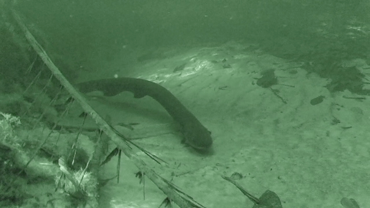Newly discovered eel sets a jolting record for animal voltage
Scientists have found two new species, and one is quite the shocker

This newly discovered species of electric eel (Electrophorus voltai) can give quite a shock. Scientists measured a zap of 860 volts, making it the record holder among known species.
L. Sousa
Electric eels are fish with organs that can generate an electric charge. Scientists thought all electric eels belonged to one species. But a new study has found there are three. And one of the new species unleashes the highest voltage of any known animal.
Electric eels use strong zaps to defend themselves and take down prey. They also send out weaker pulses to sense hidden prey and communicate with each other. One of the newly found species has been named Electrophorus voltai. It can deliver a shocking 860 volts. That’s way higher than the 650 volts recorded for eels — back when they were all called E. electricus.
David de Santana calls himself a “fish detective.” This zoologist works at the Smithsonian Institution’s National Museum of Natural History. That’s in Washington, D.C. De Santana and his colleagues described the new eels in Nature Communications on September 10.
These eels aren’t exactly new kids on the block. But this is the first “discovery of a new species … after more than 250 years,” de Santana reports.
Electric eels live in a range of habitats in South America’s Amazon rainforest. It’s rare to see just one fish species spread across such different habitats in this area, de Santana says. So the scientists suspected that other eel species lurked in the region’s rivers. It’s pretty cool, he says, to find these new species that can grow to more than 2.4 meters (8 feet).
Not just a chance find
The scientists studied 107 eels collected from Brazil, French Guyana, Guyana, Suriname, Peru and Ecuador. Most came from the wild. A few were specimens from museums. The scientists compared the eels’ physical traits and genetic differences.
They found differences between some bones. This pointed to there being two groups. But the genetic analysis suggested there actually were three.

The scientists used a computer to mathematically sort the animals. It did this on the basis of genetic similarities, notes Phillip Stoddard. He wasn’t part of the study team. A zoologist, Stoddard works at Florida International University in Miami. This eel sorting let the researchers make a family tree of sorts. More closely related animals are like twigs on the same branch. More distant relatives show up on different branches, he explains.
The scientists also used animals from each species to measure the strength of their shock. To do this, they riled up each eel with a little prod to the snout. Then they recorded the voltage between its head and tail.
Electric eels are already dramatic. But “they get a bit more dramatic as you realize they’re pushing 1,000 volts,” says Stoddard. A person probably wouldn’t feel a difference between a shock of 500 volts and anything higher. “It just hurts,” he says. Stoddard speaks from his own experience working with electric eels.
The number of samples, the difficulty of the study and the variety of methods used all make this solid work, says Carl Hopkins. A neurobiologist, he studies animal brains and behavior. He works at Cornell University in Ithaca, N.Y. Says Hopkins of the new study, “If I had to grade it like a teacher would, I would say it’s an A++ … It’s great.”
This electrifying example highlights that there are still undiscovered creatures. “We haven’t even scratched the surface in terms of understanding how many organisms are out there,” Hopkins says. He notes that the differences between the species are somewhat subtle. And, he says, “Now that this study’s been done, if people sample more widely, they may even find more [species].”







